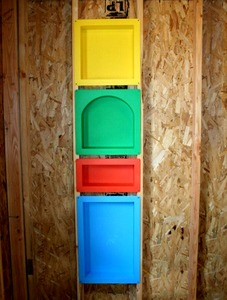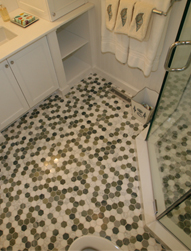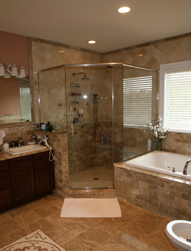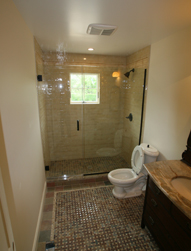FAQ
What is a mud job?
A mud job is a cement base Installation. All tile floors over a wood substrate should be set in a cement base. A correctly installed tile floor will last a life time. The method is also called floating the floor. The floor is actually separate from the substrate. Settling, expansion and contraction will not affect the floor.
What setting material should I use in a wet area?
Any area that will receive water should be set with modified thinset mortar.
What type of wall board should I use?
In any wet area cement board should be used ( wonder board or durarock).
What if I see cracking of the grout in the field of my floor
If the grout is cracking in the field of a tile floor that means the tile was not installed correctly? It is not bonded well to the base and the tiles will eventually come loose.
What are the different types of thin set?
There are basically three grades of thin set. They vary in the strength of the adhesion.
- Contractor Grades- which is the weakest good for absorbent tile like limestone and terracotta.
- Premium Bonds- which is modified and good for most porcelain or ceramic applications.
- Flex Bonds- which is very strong and will stick to wood, glass or over an existing tile.
What is the difference between Porcelain and ceramic?
The difference between Porcelain tile and ceramic tile is that the clay used in porcelain tile is more highly refined and purified. Porcelain tiles are denser than ceramic tile. Also the manufacturing processing of porcelain involves high pressure and extremely high temperatures. The water absorption rate of porcelain is less than 0.5%. Glazed porcelain tiles are much harder and more wear and damage resistant than ceramic tiles. Porcelain tiles are ideal for residential or commercial use. Highly Modified thinset cements are necessary for installation of this material due to the very qualities that make it durable.
Granite
Granite is formed from liquid magma cooled slowly. Its hardness and density comes from the fact that it has been solidified within the earth under extreme pressure. It consists of feldspar, quartz, mica and other minerals that all contribute to the unique coloration and texture of each granite deposit. Granite is much harder then marble.
Marble
Marble is a metamorphic rock formed from the recrystallization of limestone under intense pressure and high temperatures within the earth. During this process, other minerals are introduced into the structure, which produce beautiful colors and veining which characterize marble. Marble is scratch and stain-prone, as it is not as hard as a granite surface. It is not preferred in the kitchen, but works well in bathrooms, and on hearths.
Lime Stone
Lime Stone is a sedimentary rock composed largely of the mineral calcite, most commonly coming from marine organisms. Limestone often contain various amounts of silica, as well as silt, clay and sand. Limestone is softer the marble. Must be sealed if used in a wet area.
Travertine
Travertine is a sedimentary rock, mostly made of calcite that was generated by the deposit of such minerals from hot water springs and streams pouring from them. It is a very porous material, and holes are generated either by gasses trapped by the sediments or by water plants that were trapped inside the formation and then decomposed. It is highly susceptible to heat, scratching, staining, and acidity, and is not recommended for kitchen projects.
Onyx
Onyx is the result of water dissolving existing limestone and re-depositing it as a new kind of stone. In limestone caves, onyx is formed by drip water, like stalagmites and stalactites. Onyx is best for furniture pieces, bathrooms and fireplace surrounds.
What about Glass Tiles?
Glass tiles offers an appearance unachievable with conventional tiles. The depth of color combined with the reflective quality of glass results in a unique and dramatic effect. Since glass is more rigid than ceramic or porcelain tile, glass tiles break more readily under the duress of substrate shifts. Glass tile larger then 6x6 are very susceptible to cracking. Some glass tiles come with special installation instructions. Glass tile should always be installed with the highest grade modified white thinset.
What is Wet Setting?
The cement is not allowed to set over night. This method is not use as much today as in the past for a few reasons. Older tiles were absorbent and pure cement would create an absorption bond to the tile. Today most tiles are porcelain and will not absorb cement. There for a chemical bond must be created with modified thin set mortars to adhere to the porcelain. Also the larger sizes and complicated lay outs make it much harder to set tile in wet mud quickly before the cement starts to set up.
What type of grout should I use?
A modified acrylic grout should always be used for grout tiles. Most tile stores will sell a liquid additive the has a sealer in it. That means the grout does not need to be sealed. Some unpolished tiles may still need to be sealed.
Recessed soap boxes




